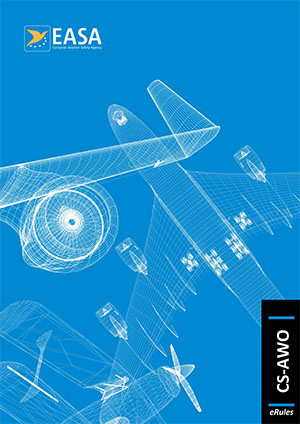CS AWO.A.HUD.105 Presentation of information to the flight crew
ED Decision 2022/007/R
(See AMC AWO.A.ALS.110)
(a) Where a HUD (or equivalent display) is used to display approach guidance, the following shall apply:
(1) Any malfunctions of the HUD (or equivalent display) which require immediate awareness and immediate or subsequent action on the part of the pilot shall be indicated by a positive and unmistakable alert to both pilots. These alerts shall be in accordance with CS 25.1322 (or equivalent applicable requirements for crew alerting).
(2) The system shall be designed such that detected failures will cause the immediate removal of incorrect guidance information from view (see AMC AWO.A.HUD.105(a)(ii)).
(3) The pilot using the HUD (or equivalent display) shall be able to monitor automatic and manual flight guidance modes and system status (see AMC AWO.A.HUD.105(a)(iii)).
(4) Clear visual indication on the HUD (or equivalent display) and at the other pilot’s station (e.g. an alert light) when the aeroplane reaches the preselected DH.
(5) For normal approach cases, the HUD (or equivalent display) symbology, including guidance symbology, shall remain usable at least to the minimum use height (see CS AWO.B.SACATI.114 and CS AWO.B.CATII.114).
(b) In addition, for HUDLSs that are used for primary guidance (HUD manual landing) during Category III operations (see Subpart B Section 4), the following are also required:
(1) There shall be a means of monitoring the aeroplane’s approach and landing performance to alert both pilots to unsafe conditions.
(2) Where the flight crew consists of more than one pilot, the pilot who is not flying the aeroplane shall be provided with a display of the information necessary to support effective crew tasks for the operation.
(3) The pilot using the HUDLS shall be able to monitor the system’s operational status and approach performance continuously without referring to the HDDs.
(4) An alert of excessive deviation from the required approach path shall be provided on the HUD (or equivalent display) and at the other pilot’s station (see CS AWO.B.CATII.115).
(5) If an automatic thrust system is provided, its operation and the information provided on the HUD (or equivalent display) shall be consistent. In particular, the mode in which the autothrust is operating shall appear on the HUD (or equivalent display), and the system’s operation shall not adversely affect the pilot’s control of the aircraft when using the HUDLS.
[Issue: CS-AWO/2]
AMC AWO.A.HUD.105(a)(ii) Indications and alerts
ED Decision 2022/007/R
The removal of the total display may be an acceptable way of indicating a failure of the system.
[Issue: CS-AWO/2]
AMC AWO.A.HUD.105(a)(iii) Indications provided to the pilot
ED Decision 2022/007/R
As indicated in CS 25.1329, it is essential that both pilots are aware at all times of the mode of flight guidance being used. Unless the format of the display on the HUD is unique to a particular guidance mode, the pilot using the HUD (whether in automatic or manual flight) will need to have their attention brought to any normal or uncommanded changes of mode as soon as they occur.
[Issue: CS-AWO/2]
AMC AWO.A.HUD.105(b)(2) Information to the pilot monitoring
ED Decision 2022/007/R
The pilot who is not flying the aeroplane should be provided with a display of the adequacy with which the pilot flying is tracking the HUDLS commands.
[Issue: CS-AWO/2]
CS AWO.A.HUD.106 Flight data recording
ED Decision 2022/007/R
Where a HUD (or equivalent display) is installed, a ‘HUD in use’ parameter and, if applicable, the mode of the HUD operation shall be recorded on the flight data recorder in accordance with CS 25.1459(e) when a flight data recorder is required to be installed.
[Issue: CS-AWO/2]
